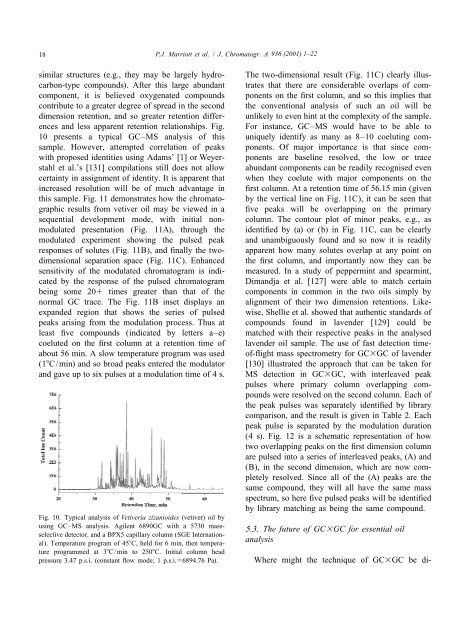Gas chromatographic technologies for the analysis of essential oils
Gas chromatographic technologies for the analysis of essential oils
Gas chromatographic technologies for the analysis of essential oils
You also want an ePaper? Increase the reach of your titles
YUMPU automatically turns print PDFs into web optimized ePapers that Google loves.
18 P.J. Marriott et al. / J. Chromatogr. A 936 (2001) 1–22<br />
similar structures (e.g., <strong>the</strong>y may be largely hydro- The two-dimensional result (Fig. 11C) clearly illuscarbon-type<br />
compounds). After this large abundant trates that <strong>the</strong>re are considerable overlaps <strong>of</strong> comcomponent,<br />
it is believed oxygenated compounds ponents on <strong>the</strong> first column, and so this implies that<br />
contribute to a greater degree <strong>of</strong> spread in <strong>the</strong> second <strong>the</strong> conventional <strong>analysis</strong> <strong>of</strong> such an oil will be<br />
dimension retention, and so greater retention differ- unlikely to even hint at <strong>the</strong> complexity <strong>of</strong> <strong>the</strong> sample.<br />
ences and less apparent retention relationships. Fig. For instance, GC–MS would have to be able to<br />
10 presents a typical GC–MS <strong>analysis</strong> <strong>of</strong> this uniquely identify as many as 8–10 coeluting comsample.<br />
However, attempted correlation <strong>of</strong> peaks ponents. Of major importance is that since comwith<br />
proposed identities using Adams’ [1] or Weyer- ponents are baseline resolved, <strong>the</strong> low or trace<br />
stahl et al.’s [131] compilations still does not allow abundant components can be readily recognised even<br />
certainty in assignment <strong>of</strong> identity. It is apparent that when <strong>the</strong>y coelute with major components on <strong>the</strong><br />
increased resolution will be <strong>of</strong> much advantage in first column. At a retention time <strong>of</strong> 56.15 min (given<br />
this sample. Fig. 11 demonstrates how <strong>the</strong> chromato- by <strong>the</strong> vertical line on Fig. 11C), it can be seen that<br />
graphic results from vetiver oil may be viewed in a five peaks will be overlapping on <strong>the</strong> primary<br />
sequential development mode, with initial non- column. The contour plot <strong>of</strong> minor peaks, e.g., as<br />
modulated presentation (Fig. 11A), through <strong>the</strong> identified by (a) or (b) in Fig. 11C, can be clearly<br />
modulated experiment showing <strong>the</strong> pulsed peak and unambiguously found and so now it is readily<br />
responses <strong>of</strong> solutes (Fig. 11B), and finally <strong>the</strong> two- apparent how many solutes overlap at any point on<br />
dimensional separation space (Fig. 11C). Enhanced <strong>the</strong> first column, and importantly now <strong>the</strong>y can be<br />
sensitivity <strong>of</strong> <strong>the</strong> modulated chromatogram is indi- measured. In a study <strong>of</strong> peppermint and spearmint,<br />
cated by <strong>the</strong> response <strong>of</strong> <strong>the</strong> pulsed chromatogram Dimandja et al. [127] were able to match certain<br />
being some 201 times greater than that <strong>of</strong> <strong>the</strong> components in common in <strong>the</strong> two <strong>oils</strong> simply by<br />
normal GC trace. The Fig. 11B inset displays an alignment <strong>of</strong> <strong>the</strong>ir two dimension retentions. Likeexpanded<br />
region that shows <strong>the</strong> series <strong>of</strong> pulsed wise, Shellie et al. showed that au<strong>the</strong>ntic standards <strong>of</strong><br />
peaks arising from <strong>the</strong> modulation process. Thus at compounds found in lavender [129] could be<br />
least five compounds (indicated by letters a–e) matched with <strong>the</strong>ir respective peaks in <strong>the</strong> analysed<br />
coeluted on <strong>the</strong> first column at a retention time <strong>of</strong> lavender oil sample. The use <strong>of</strong> fast detection timeabout<br />
56 min. A slow temperature program was used <strong>of</strong>-flight mass spectrometry <strong>for</strong> GC3GC <strong>of</strong> lavender<br />
(18C/min) and so broad peaks entered <strong>the</strong> modulator [130] illustrated <strong>the</strong> approach that can be taken <strong>for</strong><br />
and gave up to six pulses at a modulation time <strong>of</strong> 4 s. MS detection in GC3GC, with interleaved peak<br />
pulses where primary column overlapping compounds<br />
were resolved on <strong>the</strong> second column. Each <strong>of</strong><br />
<strong>the</strong> peak pulses was separately identified by library<br />
comparison, and <strong>the</strong> result is given in Table 2. Each<br />
peak pulse is separated by <strong>the</strong> modulation duration<br />
(4 s). Fig. 12 is a schematic representation <strong>of</strong> how<br />
two overlapping peaks on <strong>the</strong> first dimension column<br />
are pulsed into a series <strong>of</strong> interleaved peaks, (A) and<br />
(B), in <strong>the</strong> second dimension, which are now completely<br />
resolved. Since all <strong>of</strong> <strong>the</strong> (A) peaks are <strong>the</strong><br />
same compound, <strong>the</strong>y will all have <strong>the</strong> same mass<br />
spectrum, so here five pulsed peaks will be identified<br />
by library matching as being <strong>the</strong> same compound.<br />
Fig. 10. Typical <strong>analysis</strong> <strong>of</strong> Vetiveria zizanioides (vetiver) oil by<br />
using GC–MS <strong>analysis</strong>. Agilent 6890GC with a 5730 mass-<br />
5.3. The future <strong>of</strong> GC3GC <strong>for</strong> <strong>essential</strong> oil<br />
selective detector, and a BPX5 capillary column (SGE Internation<strong>analysis</strong><br />
al). Temperature program <strong>of</strong> 458C, held <strong>for</strong> 6 min, <strong>the</strong>n temperature<br />
programmed at 38C/min to 2508C. Initial column head<br />
pressure 3.47 p.s.i. (constant flow mode; 1 p.s.i.56894.76 Pa). Where might <strong>the</strong> technique <strong>of</strong> GC3GC be di-











![Bericht von Schimmel & Co. [Inhaber Gebr. Fritzsche] in Leipzig](https://img.yumpu.com/24438150/1/171x260/bericht-von-schimmel-co-inhaber-gebr-fritzsche-in-leipzig.jpg?quality=85)




